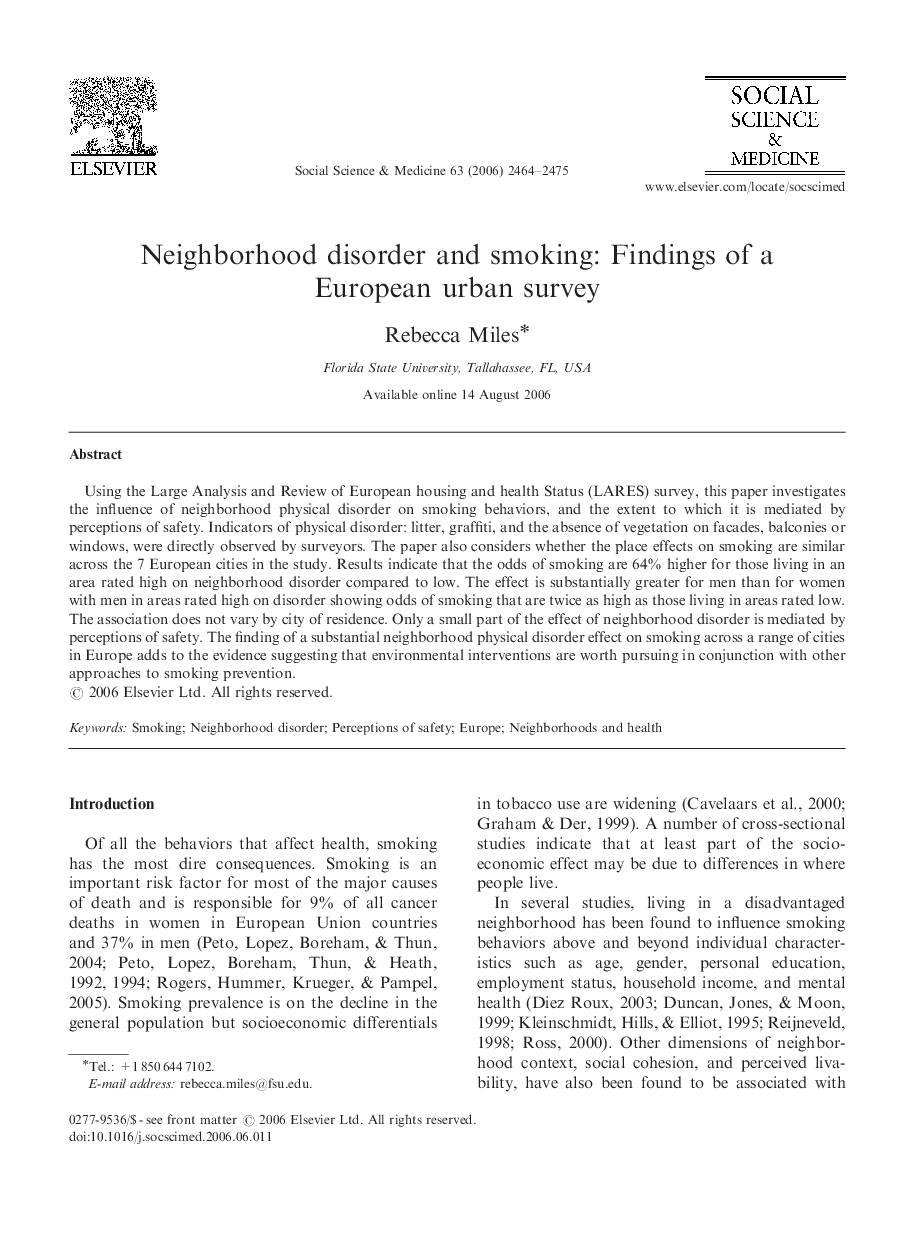Using the Large Analysis and Review of European housing and health Status (LARES) survey, this paper investigates the influence of neighborhood physical disorder on smoking behaviors, and the extent to which it is mediated by perceptions of safety. Indicators of physical disorder: litter, graffiti, and the absence of vegetation on facades, balconies or windows, were directly observed by surveyors. The paper also considers whether the place effects on smoking are similar across the 7 European cities in the study. Results indicate that the odds of smoking are 64% higher for those living in an area rated high on neighborhood disorder compared to low. The effect is substantially greater for men than for women with men in areas rated high on disorder showing odds of smoking that are twice as high as those living in areas rated low. The association does not vary by city of residence. Only a small part of the effect of neighborhood disorder is mediated by perceptions of safety. The finding of a substantial neighborhood physical disorder effect on smoking across a range of cities in Europe adds to the evidence suggesting that environmental interventions are worth pursuing in conjunction with other approaches to smoking prevention.
Of all the behaviors that affect health, smoking has the most dire consequences. Smoking is an important risk factor for most of the major causes of death and is responsible for 9% of all cancer deaths in women in European Union countries and 37% in men (Peto, Lopez, Boreham, & Thun, 2004; Peto, Lopez, Boreham, Thun, & Heath (1994) and Peto, Lopez, Boreham, Thun, & Heath (1992); Rogers, Hummer, Krueger, & Pampel, 2005). Smoking prevalence is on the decline in the general population but socioeconomic differentials in tobacco use are widening (Cavelaars et al., 2000; Graham & Der, 1999). A number of cross-sectional studies indicate that at least part of the socioeconomic effect may be due to differences in where people live.
In several studies, living in a disadvantaged neighborhood has been found to influence smoking behaviors above and beyond individual characteristics such as age, gender, personal education, employment status, household income, and mental health (Diez Roux, 2003; Duncan, Jones, & Moon, 1999; Kleinschmidt, Hills, & Elliot, 1995; Reijneveld, 1998; Ross, 2000). Other dimensions of neighborhood context, social cohesion, and perceived livability, have also been found to be associated with smoking behavior (Blackman, 2005; Patterson, Eberly, Ding, & Hargreaves, 2004).
The findings of this analysis of smoking behaviors in 7 European cities indicate that smoking is significantly associated with the physical disorder of local neighborhood environments, and that this relationship is not significantly different in size or direction across the cities in the study. The measure of disorder is based on direct observations by trained surveyors of indicators of neighborhood physical disorder: the presence of graffiti and litter, and the absence of vegetation on facades, balconies, or windows. Across the cities in the study, places rated high on physical disorder are more likely to be located in neighborhoods with high residential density, compared to areas rated low. Furthermore, the residents of such places are more likely to report not feeling safe returning home at night, and being bothered by traffic and general neighborhood noise, suggesting a lower quality-of-life in neighborhoods rated high on physical disorder.
The effect of neighborhood physical disorder on smoking behaviors is substantial, ranging from a main effect of 64% to a 2-fold increase when men are analyzed separately. Only a small part of the effect is mediated by perceived safety. The finding that the effect of neighborhood disorder on smoking is significantly less important for women than for men is consistent with a study of a population in Illinois, USA, indicating that neighborhood poverty affects men's smoking but not women's (Ross, 2000). It is inconsistent, however, with studies by Duncan et al. (1999) and Kleinschmidt et al. (1995) who do not find a significantly different association between neighborhood deprivation and smoking in UK populations for men and women.


